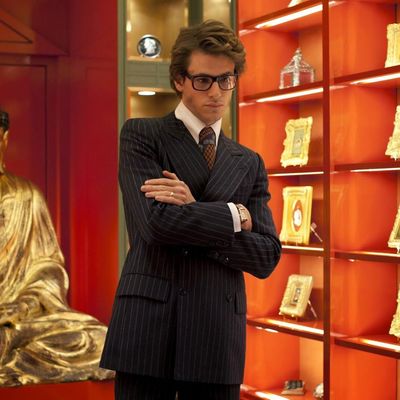
Bertrand Bonello’s Saint Laurent is a beautiful movie about being lost, but don’t be surprised if you feel a little lost yourself watching it. A shape-shifting journey through the life and career of Yves Saint Laurent, it probably won’t teach you anything particularly new about the famous designer — other than the fact that, like most artists who get movies made about them, he spent a sizable portion of his life descending into addiction and had trouble finding his way out. Instead, Bonello gives us fragmented glimpses of key events in YSL’s life — all in an effort to capture something ineffable about the man. I knew almost nothing about fashion going in, and I think I knew even less coming out. But I was still awed by the film.
Saint Laurent confines most of its action to the 1970s. It opens in 1974, with the designer (played by an uncommonly fragile Gaspard Ulliel) checking into a Paris hotel under the Proustian pseudonym Swann — saying he’s there “to sleep.” With the Eiffel Tower looming in the fog outside his hotel room window, he gives an unusually confessional interview over the phone, quietly talking about his stint in an asylum during the Algerian War. Then we briefly see Yves passed out in a pile of dirt in a construction zone. But just as quickly, we see him back at his fashion house, as various white dresses are crafted and models are fitted by women in white coats, with almost clinical professionalism — you could almost imagine that these workers are not so different from the doctors YSL would have seen in that asylum. We’re already adrift in time, but this dialectic of images — the loneliness and the brokenness, followed by the redemptive, almost therapeutic bustle — governs Bonello’s film.
Much of Saint Laurent dwells on the designer’s obsession with Jacques de Bascher (Louis Garrel), an aristocratic party boy into drugs and S&M, even as he continues his more stable relationship with Pierre Bergé (Jeremie Renier), his patient business partner. But even this love triangle is treated in fragmented, hallucinatory fashion, with moments of tenderness jutting up against orgy scenes, an uneasy mix of the mundane and the unreal. All throughout, Bonello isolates his central character: Yves seems lost and alone whether he’s in his atelier creating, anxiously cruising a city street at night looking for action, or holding court in a crowded discotheque. (Ulliel’s performance is critical here: He never loses sight of the character’s longing and awkwardness.)
Saint Laurent isn’t exactly formless, however. All throughout, we see the hubbub of activity at the fashion house, as the workers busily cut and sew and struggle while Yves, increasingly secluded in his office, finds it harder and harder to work, slipping into alcoholism, profligacy, and madness. (He also seems like a lousy boss: Upon learning that one of his workers needs an abortion, he gives her a wad of cash, then tells her superior to fire the girl.)
Creation serves as both Yves’s demon and savior: Bonello jumps in time all over the place — even flashing forward to Saint Laurent’s reclusive elderly years — but structurally, the film builds to the designer’s triumphant 1976 show presenting his fall/winter ‘76/’77 line. Here, in one of the most sublime sequences I’ve experienced in any recent movie, Bonello presents the event from a variety of fractured angles, in a split-screen composed like a Mondrian. The central dynamic of the sequence is built around two main elements. In one, the camera follows the models in medium-shot, the rustle of the cloth and the baroque elegance of the music and setting serving to create an alternate reality, one divorced from the base concerns of this world. Meanwhile, Bonello cuts to a close-up of Yves peeking from behind a nondescript wall, anxiously surveying his models but powerless in the presence of his own creation. At one point, the designer reaches over to fix something on a girl as she saunters out, but she barely sees him, and his fumbling grasp nearly eludes her. His art belongs to the ages now. It’s left him behind.
Watching Saint Laurent, I was reminded constantly of the work of Luchino Visconti. Both through the references to Proust and to Ludwig II, the mad king of Bavaria — two key Visconti obsessions — but also in the film’s paradoxical relationship to decadence and class. Visconti, the Marxist count, was a man of many contrasts, and so was his cinema: His films indulged in ornate and immersive re-creations of old-world splendor, even as they deconstructed and analyzed them. Saint Laurent clearly invites the comparison: Visconti’s The Damned shows up on TV at one point, and Helmut Berger, the Italian director’s star and lover in his later years, actually plays the older Saint Laurent. You could say that Bonello’s film combines the qualities of Visconti’s so-called German Trilogy: The diseased hedonism of The Damned, the melancholy romanticism of Death in Venice, and the delusional isolation of Ludwig. Here, Yves Saint Laurent loses himself in his world, but he manages to create something genuinely beautiful out of it — something that, at least in this film’s conception, contributes to his own eventual demise.
Because the Yves Saint Laurent we see here is a prisoner — of his class, of his impulses, of his own achievement. All through the film, Yves collects artwork and other objects — paintings, statues, furniture, knickknacks. At first, it seems to come from a desire to surround himself with beautiful things, but later, it starts to feel compulsive: The objects speak to an inability to let go. The film feels like a cinematic expression of that clutter. It hoards characters, memories, and feelings. The gorgeous, thrilling, relentless cadence of its images and sounds creates a kind of gilded prison. By the time I stepped out of the theater, I was both grateful for the release and eager to experience it all again.





